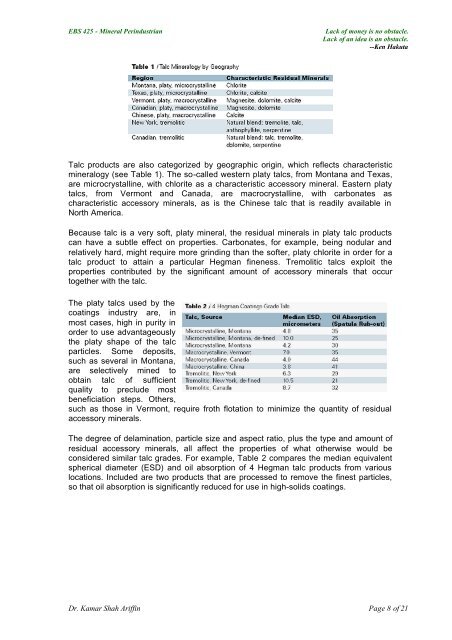Talc and pyrohyllite
Talc and pyrohyllite
Talc and pyrohyllite
You also want an ePaper? Increase the reach of your titles
YUMPU automatically turns print PDFs into web optimized ePapers that Google loves.
EBS 425 - Mineral Perindustrian Lack of money is no obstacle.<br />
Lack of an idea is an obstacle.<br />
--Ken Hakuta<br />
<strong>Talc</strong> products are also categorized by geographic origin, which reflects characteristic<br />
mineralogy (see Table 1). The so-called western platy talcs, from Montana <strong>and</strong> Texas,<br />
are microcrystalline, with chlorite as a characteristic accessory mineral. Eastern platy<br />
talcs, from Vermont <strong>and</strong> Canada, are macrocrystalline, with carbonates as<br />
characteristic accessory minerals, as is the Chinese talc that is readily available in<br />
North America.<br />
Because talc is a very soft, platy mineral, the residual minerals in platy talc products<br />
can have a subtle effect on properties. Carbonates, for example, being nodular <strong>and</strong><br />
relatively hard, might require more grinding than the softer, platy chlorite in order for a<br />
talc product to attain a particular Hegman fineness. Tremolitic talcs exploit the<br />
properties contributed by the significant amount of accessory minerals that occur<br />
together with the talc.<br />
The platy talcs used by the<br />
coatings industry are, in<br />
most cases, high in purity in<br />
order to use advantageously<br />
the platy shape of the talc<br />
particles. Some deposits,<br />
such as several in Montana,<br />
are selectively mined to<br />
obtain talc of sufficient<br />
quality to preclude most<br />
beneficiation steps. Others,<br />
such as those in Vermont, require froth flotation to minimize the quantity of residual<br />
accessory minerals.<br />
The degree of delamination, particle size <strong>and</strong> aspect ratio, plus the type <strong>and</strong> amount of<br />
residual accessory minerals, all affect the properties of what otherwise would be<br />
considered similar talc grades. For example, Table 2 compares the median equivalent<br />
spherical diameter (ESD) <strong>and</strong> oil absorption of 4 Hegman talc products from various<br />
locations. Included are two products that are processed to remove the finest particles,<br />
so that oil absorption is significantly reduced for use in high-solids coatings.<br />
Dr. Kamar Shah Ariffin Page 8 of 21


